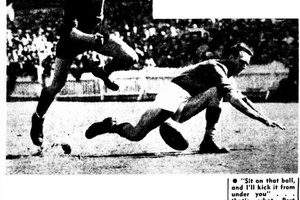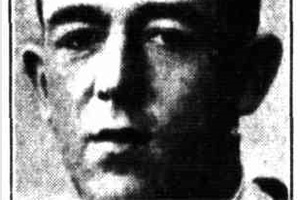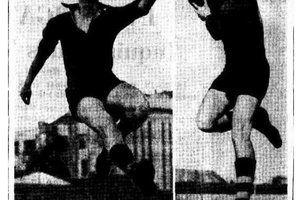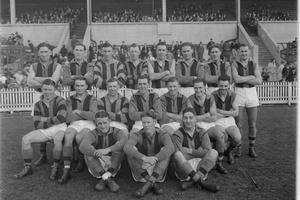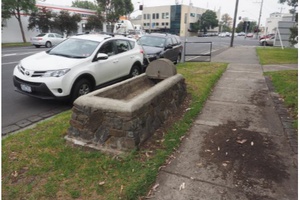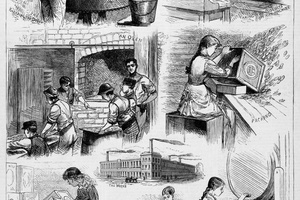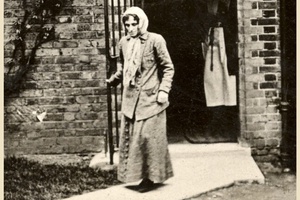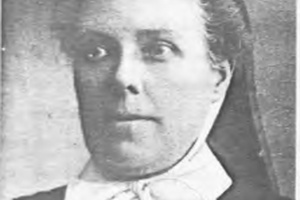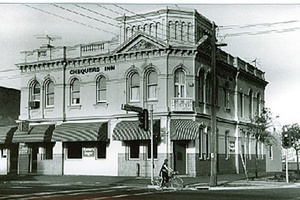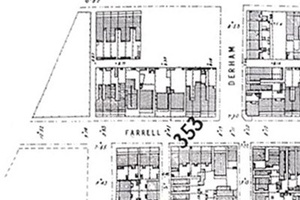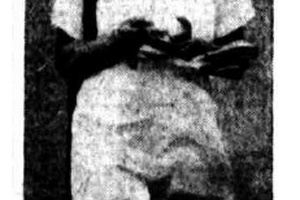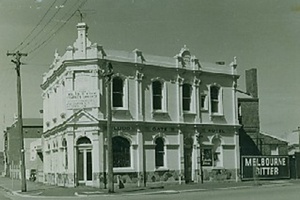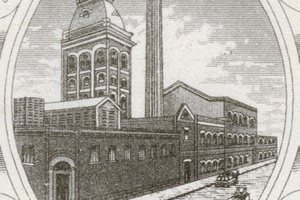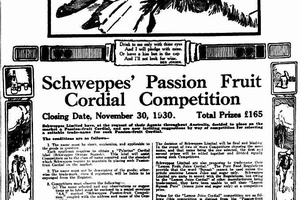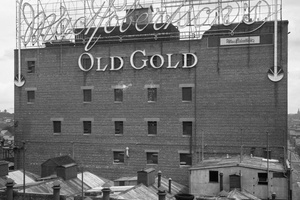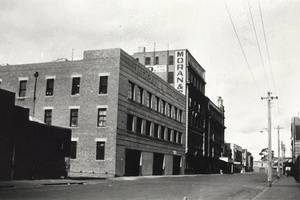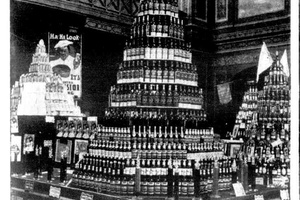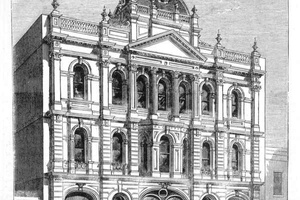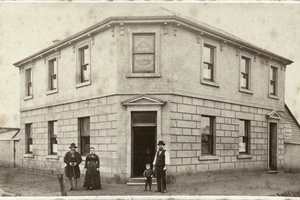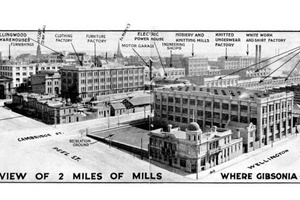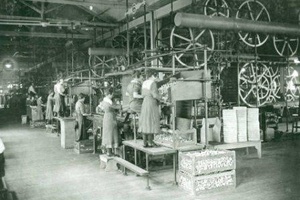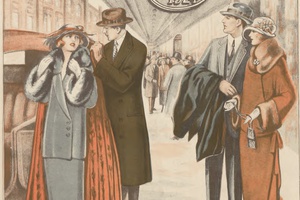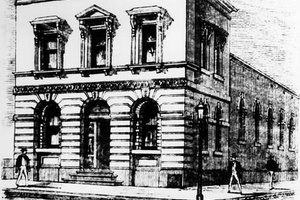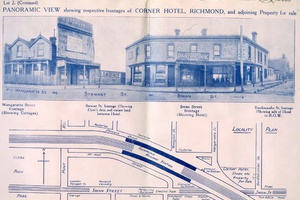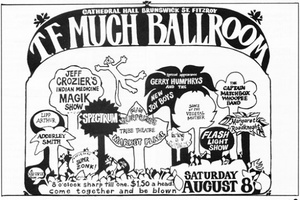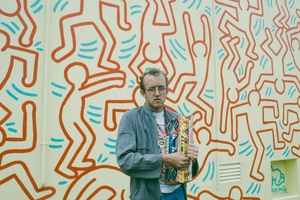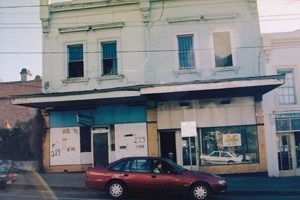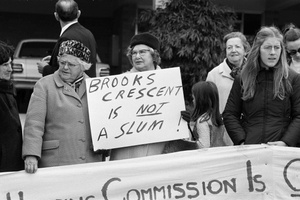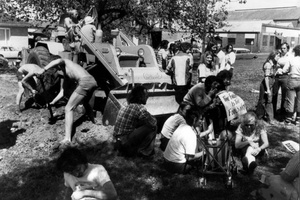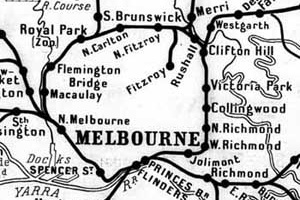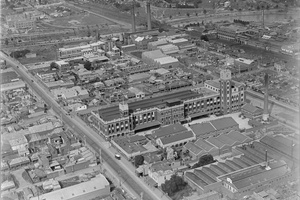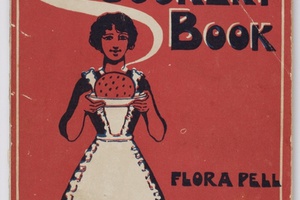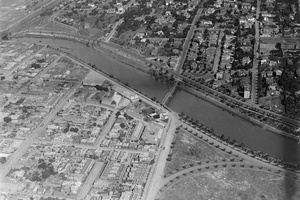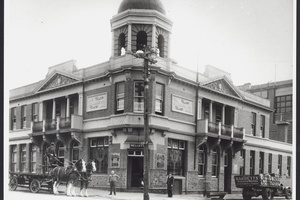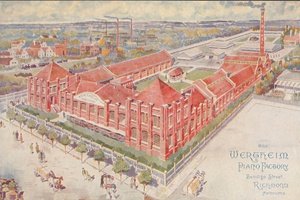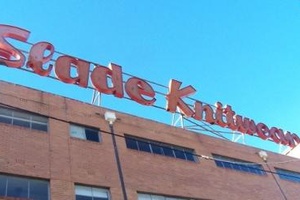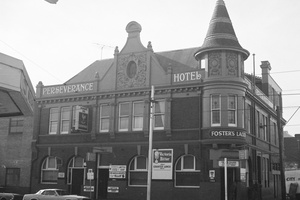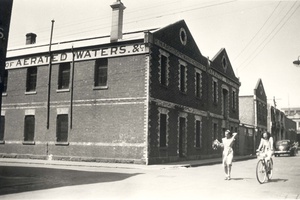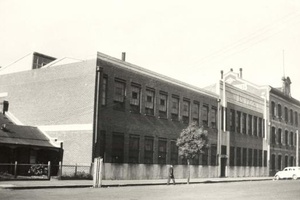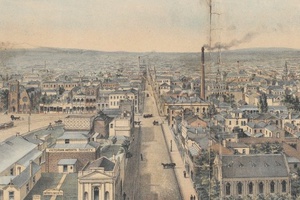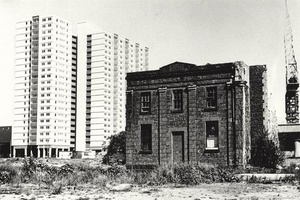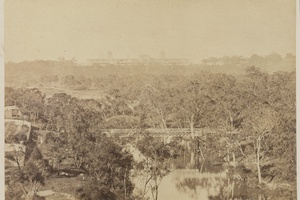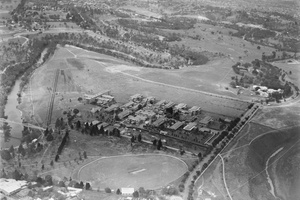This item is a part of these Tours
Heritage from the Tram: Route 86
Jump To TourThis record is a stop on a tour which goes to other places. Pick up the tour by jumping to it from here. Check the map to see where it goes. You can jump back to this place later.
Other content from this author
-
Brian Buckley, 249 The Boulevard
Brian Buckley, former captain and coach of Port Melbourne from 1966 to 1968, lived at 249 The Boulevard Port Melbourne. Buckley played for Carlton in the VFL until 1966, when he joined Port Melbourne as captain and coach. After leading the Borough to a premiership in 1966, the following year Buckley led the club to a strong showing in the 1967 season, where they won 13 of 18 games. In the Grand Final against Dandenong on 17 September 1967, Buckley attempted to lead a player walk-off partway through the second quarter after controversial umpiring decisions and an unbalanced award of free kicks favouring Dandenong. While half of the club had nearly left the field, the umpire made the decision to continue play, and the club secretary and treasurer ordered the team to return to the field. While Port Melbourne made a comeback in the second half, Dandenong eventually won 16.13.109 to 12.12.84. The aftermath of the game proved just as controversial with the VFA umpires’ adviser asking for a formal inquiry into the walkoff, arguing that Port Melbourne officials had requested it from “outside the fence,” while Port Melbourne’s official response stated that this decision was entirely made by Buckley. Buckley later returned to Carlton as assistant coach to their premiership years of 1978 and 1979.
laurenpiko
-
Bob Bonnett, 278 Williamstown Road
Bob Bonnett lived at 278 Williamstown Road during part of his long career at Port Melbourne Football Club. Bonnett joined Port Melbourne’s seconds in 1951 and played his first senior game in 1952, and would play for a total of 229 games for the club over his career until retiring in 1963. Bonnett is best known for his record-breaking goal-kicking, with a total of 933 goals for Port Melbourne over the 12 years of his senior career making him the third-highest goal-kicker in VFA history. In honour of this achievement, in 2014 the Williamstown Road end goals of North Port Oval were named after Bonnett. After retiring from the senior team in 1963, Bonnett returned to the seconds as captain-coach before returning to coach the seniors from 1969 to 1971.
laurenpiko
-
Peter Bedford, 7 Edwards Avenue
Peter Bedford lived at 7 Edwards Avenue during his time with Port Melbourne Football Club, including the 1967 season culminating in the controversial Grand Final of that year. During that game, Dandenong’s Alan Osborne was reported for kicking Bedford during one of the many physical altercations in the first quarter, which contributed to captain-coach Brian Buckley’s decision to attempt a walk-off in the second quarter. During that same year, Bedford played in the Victorian cricket team. This led to his receiving an unusual joint offer in 1967, from both Port Adelaide’s team in the South Australian National Football League and the South Australian cricket team. Sir Donald Bradman, who was then selector for South Australia, was particularly interested in Bedford, however he chose to remain in Victoria, moving to South Melbourne’s VFL team from 1968. In 2003, Bedford was named on the Port Melbourne “team of the century”.
laurenpiko
-
Railway United Football Club
Port Melbourne and South Melbourne Football Clubs, while by far the largest football clubs in the Ports area, were not the only clubs that represented the local community. In addition to these major league clubs, during the late nineteenth and early twentieth centuries, many of the larger local industrial employers had their own football clubs. Some of these clubs were informal, while others played in the Victorian Junior Football Association league, and from 1927 some of these teams played in the formally organised Saturday Morning Industrial League which was strongly supported by the Port Melbourne community. One of the most noteworthy of these clubs was the Railway United football club, whose players worked on the Sandridge railway, whose station is preserved here. This club formed during the early 1900s and in 1910 won the premiership in the Victorian Junior Football Association’s first grade league. From this time they were often considered the “junior league” to the Port Melbourne Football Club, even though at times there were financial tensions between the two clubs regarding costs of using the local grounds. When the VFA cancelled the football season in 1916 due to the ongoing First World War, the Junior league did not cancel their games, and during this time the Railway United Club was especially strongly supported by locals as they represented Port Melbourne around Victoria. Elsewhere, the Railway Club Hotel at 107 Raglan St, built in 1876, was the second hotel of this name in Port Melbourne, and was named for its association with railway workers during this period.
laurenpiko
-
Swallows and Ariells biscuit factory: industrial football
The Swallows and Ariells biscuit factory was not only a major employer for Port Melbourne, but was also an important part of local football. Thomas Swallow was influential in the forming of the Sandridge Cricket Club in 1874, and that same year, the Alma Cricket Club based in Emerald Hill established its football team, which became the Sandridge Alma Football Club. In 1877, the Club became the Sandridge Football Club and Swallow was elected its first president. Swallows and Ariells also had a factory football team. The early Swallows team of the 1880s was likely to have been formed to play games for major holidays and events, some of which were very popular local events: in 1883, the Swallows and Ariells team played Kitchen and Sons’ factory team in front of a crowd estimated at eight hundred people. In June 1914 the Swallows team won a one-off game against the West Melbourne biscuit factory T.B. Guests which was the source of much local pride, and led to the Swallows factory establishing a standing team. The Port Melbourne Standard reported that some of the Swallows players “had never played in a match before, which is surprising” because of their “very promising” performance. In 1915, however, the team suffered some losses, and the Port Melbourne Standard explained that “as a lot of Swallows’ players had gone up to enlist the team had been very much weakened.” Nonetheless the team was strongly supported throughout the War, and Swallows games were often used as fundraisers for the war effort and for returned soldiers.
laurenpiko
-
Bill Findlay, 88 Princes Street
Bill Findlay lived at 88 Princes Street during his time with Port Melbourne Football Club. Bill Findlay joined the club in 1946, after a career playing for Footscray and North Melbourne in the VFL, where he had consistently led goal-kicking record tables. Findlay’s appointment at Port Melbourne was reported by the Emerald Hill Record as “most popular among officials and members alike” due to both his “almost perfect exhibition of the [VFL] code.” He continued this impressive record at the Borough, kicking 88 goals for the club in 1946, and won the Liston Trophy that year. Findlay went on to set the VFA record in 1947 with 107 goals for the season, alongside leading Port Melbourne to the VFA Premiership as captain and coach. Findlay was named as a rover on the Port Melbourne “team of the century” in 2003.
laurenpiko
-
Tommy Lahiff, 261 Graham Street
Tommy Lahiff lived at 261 Graham Street, Port Melbourne for most of his life, including throughout his time with Port Melbourne Football Club. Lahiff represented Port Melbourne in a range of sports, including cricket, basketball, and playing football for his employer Dunlop’s factory team in the Saturday Morning Industrial League. His first stint at Port Melbourne Football Club was between 1930 and 1934, at which time he was recruited by the Essendon VFL club. During this time, Lahiff would spend Saturday mornings playing for the Dunlop factory team in the Saturday Morning Industrial League, while spending Saturday afternoons playing for Essendon in the VFL. He then rejoined as captain and coach in 1938 at the time of the breakdown in relations between the VFA and VFL over a range of issues including the throw-pass rule and the process of player transfers. While unlike many other key players who transferred to Port Melbourne in this period, Lahiff did obtain a clearance for his transfer, it was reported that this was only granted because he would have rejoined Port without it being given anyway. The Emerald Hill Record reported that Lahiff’s return and appointment as captain and coach to the “wildest enthusiasm” amongst club members. Lahiff coached the club to their premiership in 1941, however after this season the VFA suspended competition for the remainder of the Second World War. When play resumed in 1945, Lahiff resumed as captain and coach, and led Port Melbourne to the VFA grand final that year, which they lost to Williamstown. Lahiff retired at the end of the 1946 season, returning to coach for one season in 1962. Lahiff was listed on the Port Melbourne “team of the century” in 2003 as forward pocket.
laurenpiko
-
Port Melbourne Dispensary and charitable football
Football in Port Melbourne has a long tradition of raising money for charitable causes, including for local people in need as well as for the war effort. While sometimes this involved fundraising at standard games, special one-off events often took a more festive slant, including fancy dress and “muff football”, named for the fashionable item of clothing worn by women to keep their hands warm at the turn of the twentieth century. One charity event, held in August 1903 to raise money for local unemployed people, started with a procession from the Port Melbourne Dispensary building to the cricket ground which was a “quarter of a mile in length” and led to a fete featuring bands, bicycle races, acrobatics, and a “muff football” match in front of over 2000 Port Melbourne residents. In 1905, an even more elaborate fundraising football game was played as part of Port’s “Bizarre Carnival”, where Port’s best eighteen players wore bell-topper hats, against a side of “Theatricals”, or local performers, who dressed as clowns. This was followed by a mixed cricket match between Port Melbourne Cricket Club’s best 11, and a team of “10 ladies and one gentleman (“lucky Jim”). This event was very popular locally, however its "bizarre" fancy dress was controversial, and Port Melbourne Council was keen to emphasise that Councillors did not participate in an official capacity.
laurenpiko
-
Football in the streets of Port Melbourne
Football in Port Melbourne has not always just been played on the field. In July 1884, five Port Melbourne players appeared in the Police Court at Port Melbourne Town Hall, charged with “unlawfully playing a game, to wit, football,” on Bay Street. The court heard that on 4 July between 1pm and 2pm, the players were kicking a football to each other down the length of Bay Street opposite the town hall. Their ball went through a window of the house of local resident Michael Quinn, who “was annoyed by their play, and cautioned them, in a friendly manner, to desist.” The players were known to “frequently” play in Bay Street, and a witness also reported their playing in Spring Street as well. In light of the risk to “the public and to property,” the players were fined 1 shilling each. The streets of Port Melbourne saw plenty of informal games of football being played – including by local women and girls. The sight of girls playing football in nearby McCormack St in 1902 was unusual enough to be reported in the Port Melbourne Standard.
laurenpiko
-
Ted and Rob Freyer, 37 Heath St
Edward Freyer, known as Ted or Teddy, lived at 37 Heath Street with his family throughout his time with Port Melbourne Football Club. Freyer started his football career in the VFL at Essendon, kicking 372 goals in 124 games between 1929 and 1937. Freyer’s impressive record meant he was in high demand, and Port Melbourne struggled to obtain an official transfer, with tense negotiations reflecting the deteriorating relationship between the VFL and VFA in 1938. Freyer eventually transferred without a clearance, and immediately made a significant impact on the team. Notable performances including his record-setting 13 goals against Sandringham in July 1938, and kicking four goals in ten minutes against Brunswick in 1939. The Emerald Hill Record reported an astonishing story of Freyer’s return home to Heath Street after winning the 1940 premiership: “Mr. Kent drove Ted Freyer to his home in Port Melbourne to enable the champion goalkicker to deposit his kitbag and accept the congratulations of his wife and a son [Robert] who has been bedridden with infantile paralysis for over three years. Leaving his kitbag on the invalid youngster's bed, Freyer left the room, and on returning was astounded to see that the youngster had moved to the foot of the bed, his father's football guernsey on, saying: 'Look, Daddy, Teddy Freyer— am I any good?' The shock temporarily dazed the champion for it was the first occasion since the lad was stricken that he was able to control his muscular movements. It was a delighted father who later visited the Port Melbourne oval to join in the celebrations with his team-mates.” Robert Freyer would go on to play 109 games for Port Melbourne Football Club from 1958 to 1965, winning best and fairest in 1963 and playing in the winning premiership side in 1964. He was named alongside his father on the half forward line of Port Melbourne’s Team of the Century in 2003.
laurenpiko
-
Alby Lewis, 233 Ross Street
Alby Lewis, who played over 100 games for the club including the 1947 premiership, lived at 233 Ross Street throughout his time with the club, including during the periods in which he was the subject of fierce bidding wars. In May 1945, after two years of playing for Port Melbourne, Lewis caused a “mild sensation” by training with South Melbourne for a crucial game against Geelong, however Port Melbourne did not approve the clearance. In November 1948, during a successful club tour of Tasmania, Lewis was secretly approached by both Hobart and North Launceston clubs to transfer without official permission, with the offer of £6 match fee as a temptation. Despite this Lewis remained a loyal Port Melbourne player throughout his time with the club, rising to vice captain in 1951. Throughout the 1920s and 1930s, 127 Ross Street was also home to Port Melbourne Football’s long-serving secretary Claude Sinclair.
laurenpiko
-
Frank Johnson Sr, 112 Evans Street
Frank Johnson Senior lived at 112 Evans Street, Port Melbourne, at the time of his greatest success with Port Melbourne Football Club. Johnson joined the Port Melbourne seniors at age 18 in 1950, and won the J.J. Liston Trophy in 1952, and was named best and fairest a record five times in eight years. Johnson was selected in 1953 and 1956 to the All-Australian team, winning the Coronation Premiership Player award in 1953, and in 1956 was named as captain. During 1956-1957, Johnson Sr coached Port Melbourne, before playing for and coaching South Warrnambool in 1958-1959. Despite concerns that, at 28, he might be “too old” to return to football on moving back to Port Melbourne, Johnson Sr played for South Melbourne in the VFL from 1960 to 1964, winning best and fairest in 1960. Unusually for a player with such a strong VFA record, in 2007 he was inducted into the AFL Hall of Fame, and the VFL’s Frank Johnson Medal, given to the best player in interstate matches, is named in his honour. In the 2003 Port Melbourne “Team of the Century,” Johnson was named captain. Frank Johnson, Jr also played for Port Melbourne Football Club, including making an impressive performance in the 1980 VFA grand final against Coburg, leading to Port Melbourne taking the premiership that year.
laurenpiko
-
The Goss Family, 150 Clark St, Port Melbourne
Several generations of the Goss family have been heavily involved in the Port Melbourne Football Club, both as players and administrators. Norm Goss Sr and his wife Lillian lived at 150 Clark St from the early 1950s onwards, where they raised their family. Norm Goss Sr played for Port Melbourne from 1937 to 1941, including in the premiership teams of 1940 and 1941. He transferred to Hawthorn in the VFL in 1942, after the VFA went into wartime recess after the 1941 grand final until 1945. When the VFA recommenced play in 1945, Goss Sr rejoined the club and played until 1947, when he took up the post of club secretary which he would hold until 1976 . In this capacity, he was one of the club officials, along with Treasurer John Paton, who intervened to stop the 1967 Grand Final walk-off. From 1976 to 1981, Goss Sr was the vice-president of the VFA, and then served two years as president of the Port Melbourne Football Club until his death in 1983. The VFA honoured Goss Sr with the establishment of the Norm Goss Memorial Medal, awarded from 1983 onwards to the best player in the VFA (now VFL) grand final. Port Melbourne have also memorialised Goss Sr’s service with the stand at North Port Oval named in his honour. Norm Goss Jr played 62 games for the club between 1968 and 1971, before going on to further success with South Melbourne and Hawthorn VFL clubs. At Port Melbourne Goss Jr was awarded best and fairest in 1969 and 1970, and was named in the Port Melbourne Team of the Century in 2003. Paul Goss played for Port Melbourne from 1973 to 1975, returning in 1977 after a season with Melbourne in the VFL, for a total of 128 games for the club, including the 1980 premiership won against Coburg. Kevin Goss played 83 games for Port Melbourne from 1977 to 1980, before playing for South Melbourne between 1980-1981.
laurenpiko
-
Ingles St horse trough
While many local supporters of Port Melbourne Football Club have travelled to home games on foot, horse-drawn transport was used in Port Melbourne throughout much of the twentieth century, and a number of public water troughs for horses have been preserved around Port Melbourne. This horse trough was constructed in the early 1940s at the order of Fred Cook, the Port Melbourne Council City Engineer, not to be confused with Port Melbourne Football Club's champion goal-kicker of the same name. This trough was originally located ten metres further along Ingles Street nearer to Williamstown Road, and was likely to have been constructed in part to meet the needs of horses who were tethered outside North Port Oval during games and major events.
laurenpiko
-
Dunlop Factory and industrial football
Like Swallows and Ariells and Kitchens and Sons, Dunlop Tyre Factory had its own industrial football team drawn from its workforce. After regularly fielding teams for one-off games throughout the late nineteenth century and early twentieth centuries, Dunlop took part in forming the Saturday Morning Industrial League in 1927 with a standing team which would play a prominent role in the new league. As a storeman at Dunlop, Tommy Lahiff played for their team in the Saturday Morning Industrial League during the early 1930s, and would then travel around Melbourne to play for Essendon in Saturday afternoon VFL games. He later described Dunlop as one of the key fixtures of Port Melbourne life during the 1930s, and claimed that, despite this gruelling schedule, playing for Dunlop was a joy: “If I hadn’t played for Dunlop I’d have done my job … But I’d have played anyway. I would have played football in the day, morning and night. I loved it that much, I couldn’t get enough of it.” While some employers reportedly insisted that employees play industrial games rather than play for VFL and VFA games during this period, this mainly affected the Wednesday Football League rather than Lahiff’s Saturday play. Dunlop attempted to use the Saturday league to trial rubber footballs to use during wet weather, however the footballs were considered “too lively” by players and so were not adopted. One of the most heavily supported Dunlop games was their “unlucky” defeat in the semi-final against the General Motors-Holden factory team in 1936, which The Age reported as “the industrial football championship of Port Melbourne.”
laurenpiko
-
Women at work: Swallow and Ariell Biscuit Factory
Swallow and Ariell Biscuit Factory was a major employer of women in Port Melbourne throughout its operation. Types of labour at the factory were largely divided along gender lines, with packaging and presentation undertaken by a larger proportion of women, while heavy mixing and larger-scale production work was undertaken by men. Women workers formed a number of social organisations which actively supported the Port Melbourne community. The most notable of these, the Busy Bees, who were involved in fundraising during the First World War, raising money for the war effort at Industrial League football games, as well as making care packages of knitted goods and food for care packages for soldiers. The Busy Bees were active well into the 1920s, when they directed their efforts towards a range of local and international causes, including raising money for Melbourne’s Women’s Hospital, and donating hand-sewn “garments for destitute Japanese children.”
laurenpiko
-
Jennie Baines, 103 Bay St
Sarah Jane Baines, better known as Jennie Baines, lived at 103 Bay St from 1926 onwards. Baines was born in Birmingham, UK in 1866, and rose to political prominence in the suffrage movement after she joined the Women’s Social and Political Union in 1903. As an organiser for the Midlands and North, Baines advocated direct action tactics and was associated with “militant” protests for women’s rights, which led to her repeated arrest and eventual imprisonment. After release from gaol in 1913, Baines and her family fled to Melbourne via Wales in order to join the work of the Women’s Political Association. While based in Fitzroy from 1913-1926, Baines’ political organising for the Women’s Peace Army and a range of socialist and Labour causes meant that she was regularly involved in Port Melbourne’s political life. Baines moved to 103 Bay St towards the end of her political career, however she stood for Port Melbourne Council in 1927 as a Political Labour League candidate, and after losing the seat continued to actively participate in the local Labour Party and in anti-war and women’s rights organisations. She was probation officer and special magistrate in the Port Melbourne Children’s Court from 1928 to 1948, with the Record reporting that “her love of humanity fitted her ideally for this job, and many a young person owes much to her kindly advice.” On her death in 1951, the Emerald Hill Record ran her obituary as front page news, and Port Melbourne Town Hall flew their flag at half mast.
laurenpiko
-
Women at work: Bay St businesses
The history of Port Melbourne’s economy is often associated with the major industrial employers and factories which employed large numbers of local residents. The census records and Sands and McDougall directories for the late 19th century show a more diverse economic picture, with a significant proportion of Port Melbourne residents listing their trades as independent craftspeople or business owners. This included many women residents, who listed their occupations in a range of fields as diverse as school teaching, proprietors of tea rooms, running grocery and specialist stores, and running businesses in baking and drapery. Bay St was the social and economic centre of the Port Melbourne area in 1880, and in that year, over a third of the businesses and shops along the street were run by women. This included Mrs Harriet Jolly, whose confectionery shop was near the intersection with Beach St, a restaurant run by Mrs Susan Litchfield, Mrs Elizabeth Davenport’s pawnbroking business, and a “registry office for servants” run by Mrs Margaret McLean. These independent businesses placed women’s work in the centre of the Port Melbourne economy.
laurenpiko
-
Temperance Hall: 146 Liardet St
The temperance movement, which advocated abstinence from alcohol, was a widespread political movement during the nineteenth century. Temperance movements were not solely run by women, but they were significantly supported by women who saw alcohol abuse as fuelling poverty and violence in their communities. It provided an important avenue for women’s political activity during this period, including married women and women with children, and temperance groups were often active in other forms of political activism including charitable work, anti-war activism, and women’s suffrage. This is especially significant in the context of Port Melbourne’s high proportion of women hotel owners and licencees during the nineteenth century: during this period, women in Port Melbourne were very active in both the business of alcohol sales, and in activism against it. Among the temperance groups active in the area, the Women’s Christian Temperance Union was one of the largest and most widely supported, with their Port Melbourne branch active from the 1880s through to the mid-1940s. The WCTU frequently collaborated with the local branch of the Melbourne City Mission, including with events such as running a Christmas party for women prisoners at Pentridge Prison in Coburg. The Temperance Hall at 146 Liardet St was constructed in 1872 and is one of the main buildings associated with the temperance movement still standing in Port Melbourne.
laurenpiko
-
Sister E.J. Todd, Melbourne City Mission, Bay St
Melbourne City Mission was founded in 1854 as a non-denominational charitable organisation focused on providing financial assistance to poor and homeless people in Melbourne, and they were active in Port Melbourne from the time of their establishment. One of Melbourne City Mission’s long-serving representatives in Port Melbourne was Sister Todd, who worked in the area from 1895 until 1911. During Sister Todd’s time with the Mission in 1906, the Mission opened Jubilee Hall at 460 Bay St to provide a base for their efforts in distributing food and clothing to Port Melbourne residents. Services at Jubilee Hall also included play groups and Sunday schools for local children. Sister Todd was extremely dedicated to her work, and her reports to the Emerald Hill Record suggest that she found it emotionally draining: she reported in 1904 that “from the beginning to the close of the year, one hears the same sad tales of want and distress. We see the unchanging scene of poverty, the unfurnished room, the fireless hearth, the empty cupboard.” The mission was especially busy during December, and Sister Todd reportedly worked 18 hours a day distributing aid in Port Melbourne during the week before Christmas in 1905. Sister Todd’s dedication to Port Melbourne was such that when MCM assigned her to another district in 1911, she refused to move, and several local groups wrote letters of protest. Eventually she resigned from Melbourne City Mission rather than move away from the community she had served since 1895.
laurenpiko
-
Women publicans in Sandridge and Port Melbourne
By 1876, 22% of alcohol licences for pubs and hotels in Melbourne were held by women, yet in the Port Melbourne area this proportion was much higher, with 68% of pubs and hotels in the South Melbourne licencing area run by women. Before the concerted efforts made to restrict licences in the late 1880s, Port Melbourne also had a far higher concentration of licenced premises than the rest of Victoria, which meant that women’s dominance of this field was more marked. In 1880, several hotels on Bay Street were run by women: the Newmarket Hotel (Mrs Caroline Streat), the Exchange Hotel at 39 Bay St (Mrs Harriet Pemberton), the Rose and Crown Hotel at 309 Bay St (Miss Bridget Torpey), Chequers Hotel at 316 Bay St (Mary Crockford), and The Victoria Hotel on the corner of Graham St (Anne Madden). Port Melbourne continued to have a higher than average proportion of women publicans after this period, as well as a high concentration of hotels relative to population. Due to the social and cultural role of hotels in the Port Melbourne area, it also placed them in prominent positions of social authority and economic power to a greater extent than in other parts of Melbourne and Australia.
laurenpiko
-
Women’s suffrage in Port Melbourne: Station St
Throughout the late nineteenth century, the issue of women’s suffrage was a major political concern throughout Australia, including in the Port Melbourne community. A number of large political meetings were held in favour of women’s suffrage in the area, which drew attendance from all over Melbourne. The Port Melbourne Council held an official public meeting to hear the views of Port Melbourne residents on the issue in 1894, with a motion in favour of women’s suffrage being passed almost unanimously, with a petition signed by attendees presented to Parliament. The 1891 “monster petition” of 300,000 signatories demanding votes for women, which is now memorialised in the “Great Petition” sculpture near Parliament House, includes 510 signatures who gave their address as Port Melbourne, including 51 signatories from Station Street alone.
laurenpiko
-
Jane Slaven: 145 Farrell St
Thomas and Jane Slaven lived at a house on this site from 1886 to 1898. Throughout the nineteenth century, the western part of Port Melbourne, including the areas of Albert St, Farrell St, Cambridge St and Clark St, was a more predominantely working class area. One of the main landowners in this area was Jane Slaven, nee McKenna. Jane McKenna was born in Ireland, and worked as a servant in Melbourne before marrying Thomas Slaven, a successful labourer who invested in over thirty properties in Port Melbourne. Jane inherited her husband’s property after his death in 1891. The cottages owned by the Slavens were constructed on low-lying land, which compounded the wider issues of sewage disposal and drainage which affected the area at this time. During the 1880s and 1890s, these properties were repeatedly named by the Port Melbourne Council as failing to provide sanitary living conditions for Slaven’s tenants, an issue which may have been compounded by damage to adjacent footpaths and sand being illegally taken from the front of the properties. Between 1896-98, a total of twenty of these cottages were condemned and then demolished by order of the City of Port Melbourne. The current house on this site was constructed by George Cuscasen in 1905 after the demolition of the earlier property. Women’s land ownership on this large scale, was not widespread in Melbourne at this time, and Slaven’s wealth and position as a property owner made her an influential figure in Port Melbourne.
laurenpiko
-
Farrell St Methodist Church
The Methodist Church in Farrell St was established in 1884 and quickly became associated with the predominantly working-class community in the western part of Port Melbourne, as distinct from the wealthier congregation of Graham St church which serviced the eastern areas. The Farrell St church was established by residents of western Port Melbourne, particularly families who lived in the cottages in the area of Clark and Cambridge Streets. The church was constructed with volunteer labour, and members of the congregation provided a library for the local community, and Sunday schooling which was initially run from local homes before the church was completed. Local women were very active in this congregation, particularly due to the class divisions which were felt between wealthier areas of Port Melbourne. When young women from the Farrell St congregation attended services at the wealthier Graham St church, for example, they were criticised by the regular congregation for their lower ‘quality’ of dress. Farrell St services drew heavily on the musical talents of their women congregants in particular, with special events featuring full programmes of choir, violin, and solo vocalists, who also performed at Graham St and local mission events.
laurenpiko
-
Peggy Antonio, test cricketer
Port Melbourne has been home to many nationally significant cricketers, including Peggy Antonio, who represented Australia in international tours during the 1930s. Peggy began playing for Raymonds’ Cricket Club in Collingwood in the early 1930s, and became nationally well-known in 1934 at age 17, after a notable performance playing for Australia against the visiting English women’s team. The Australian women’s cricket team enjoyed popular support during the 1930s, however players were not professionally employed and had to raise funds to play in international tours. This was potentially a source of their popularity, as the players were “all working girls… [who] have the real ideal of sport – wholesome recreation, devoid of the commercial taint, which spoils so much sport engaged in by men.” In order to fund her tour of England with the Australian team in 1937, the Port Melbourne community raised money including at a “Peggy Antonio Ball” held in the Port Melbourne Town Hall, an event with “great demand for tickets” which sold out quickly. After the tour completed, a major “welcome home” event was held to celebrate Antonio, with the mayor acknowledging her sporting achievements, stating “not only had she won honor for herself, but she had made Port Melbourne better known and appreciated abroad.” After retiring, she played a number of “comeback” matches including in 1949 against a visiting English team at South Melbourne. As late as 1952, Antonio’s successes were still well-remembered, with The Argus reported on her appearance in a YWCA match with the simple headline “Peggy is Back.”
laurenpiko
-
Floodgate Hotel
For much of its history, the former Floodgate Hotel was one of the many pubs in Port Melbourne’s run by women. Amongst its many licencees, some of whom ran the hotel for very brief periods, Mrs Elizabeth Short held the licence in 1880, Ellen Byrne in 1900, and Margaret Frawley in 1937 and Annie Maddock from 1940 to 1946. The Floodgate hotel was known for living up to its name; built in an area adjacent to the former Lagoon where drainage was poor, regular flooding affected the area badly, and during the 1878 floods the Floodgate was one of the “hotels .. crowded with families driven from their homes,” acting as a refuge for displaced women and children. The hotel was known for mainly being frequented by the residents of the neighbouring streets, and for its staff having a close relationship with them, which may have influenced their relaxed attitudes to licencing laws. Amongst several fines for Sunday trading incurred by the licencees of the Floodgate in the early twentieth century, in 1900 Ellen Byrne was fined a total of 44 shillings for “trafficking in liquor on Sunday.” During the early 1940s, Annie Maddock held events for children each December, enlisting local residents to act as “Father Christmas” and distribute gifts at Christmas parties.
laurenpiko
-
Dorcas St: Women and charity in Port Melbourne
During the nineteenth and early twentieth centuries, charitable work and social activism was one of the major ways that women could contribute to and participate in public life. An 1894 report from Mrs Edwards, secretary of the Port Melbourne Dorcas and Benevolent Society, reflected that despite the “extent of the poverty in the district” due to the depression, “in Port Melbourne at all events the springs of charity had not ‘run dry’.” Amongst the work of the Dorcas and Benevolent Society in supporting families and unemployed workers, the women of the society also supported “24 poor women … through their time of trouble”, with the report concluding that “the children of many of these, we have every reason to believe, would have been left motherless had it not been for the timely help afforded.” The social and religious stigma faced by unmarried mothers during the late nineteenth century often limited their ability to access charitable aid, and the non-denominational assistance of the Dorcas Society in Port Melbourne was therefore significant in providing food, money and medicines to women in need. Dorcas Street is named after this society who met in a number of houses and halls in the area.
laurenpiko
-
Former Foster's Brewery, 15 Rokeby St
The Yarra area has had a long history of brewing beer and other beverages, well before the construction of the larger large-scale Carlton and United Breweries in 1907. That brewery was established through the amalgamation of smaller local producers and businesses, including the Fosters Brewery, which was established on this site in 1888. The Fosters brothers emigrated from New York and brought with them “special appliances [for brewing] as could not be procured elsewhere”, giving their product an edge in the local market. Their 1890s beer labels advertised that their lager had won “the highest award in the world” at the Melbourne Centennial exhibition in 1889. Production of Fosters beer ceased on this site in 1907 as the brewery was amalgamated into the new Carlton and United Breweries and production moved to Abbotsford, and Joe White Maltings continued the use of this site for brewing beer up until the 1990s. The original buildings were classified by the National Trust in 1970 and recommended for formal heritage protection; a survey in 1995 described a four floor building with decorative keystone archways and rosette cornices, however this building was demolished in 2000.
laurenpiko
-
Yorkshire Brewery
By the late 1870s, Collingwood’s brewing industry was a central part of the local economy, and while many smaller companies closed or merged over time, the late 19th century saw Collingwood’s economy become dominated by the expansion of larger-scale brewers. The Yorkshire Brewery on Wellington St was one such example, and its factory on this site was constructed in 1876. The two-tone brick tower remains on site today, though an adjacent 200-foot chimney tower which vented the brewing works has been demolished. Yorkshire Brewery were early adopters of hydraulic machinery to move and transport their goods, and in 1888, they floated their business as a public company. At the first general meeting, “the directors congratulated the shareholders on possessing one of the most perfect and economically arranged buildings for brewing purposes in the colonies.” Yorkshire brewery was acquired by Carlton United Breweries in 1909 and remained part of their production until the site was was sold during the 1990s. (Note the adjacent laneway is named Brewery Lane.)
laurenpiko
-
Former Schweppe’s Cordial Factory
While the brewing industry was dominant in the Collingwood and Abbotsford area during the 19th century, the rise of the temperance movement helped drive the expansion of non-alcoholic drinks manufacturing in the area. Alongside the many brewers and pubs, inner Melbourne saw the growth of “soft drink” and cordial manufacturers to provide an alternative to beer and wine. The Swiss, and later British, company Schweppe’s expanded into Fitzroy in 1886 when Jacob Schweppe built a factory at 35 Lithgow St to manufacture “aerated waters” and cordials. Schweppes’ factories thrived during the late nineteenth century, and production continued on this site until the 1950s. Like many other specialised food and drink producers which grew during the 19th century, Schweppes International underwent mergers to consolidate their business, eventually merging with the English confectioners Cadbury in 1969 to become Cadbury Schweppes. Through the formation of this conglomerate, Schweppes was also merged with the dominant local industrial power of Macrobertson’s, whose nearby White City complex on Argyle St Fitzroy had been acquired by Cadbury only two years previously.
laurenpiko
-
Former Macrobertson's "White City" confectionery factory
The MacRobertson’s Steam Confectionery Works operated on this site from the early 1880s. MacPherson Robertson, born on the Ballarat Goldfields in 1859, began his own confectionery company in his bathroom in Fitzroy in 1880, and demand for his products from local shopkeepers led to his purchasing land at 214 Argyle St to construct his first factory. The scale of the production expanded substantially, leading to the acquisition and demolition of surrounding housing to construct new factories. MacRobertson’s swift expansion was partly tied to their constant expansion of their range of products including the Freddo Frog, Cherry Ripe, and Old Gold; by 1923, the Argyle St factories made 700 different confectionery products, and by 1930, the factories employed 2,600 people. The brand’s reputation was closely associated with the personal reputation of MacPherson Robertson himself, from his signature acting as the logo for his factory’s products to the success of his popular “rags to riches” memoir 'A Young Man and a Nail Can' published in 1921. His innovative approach to branding and marketing extended to the form of the Argyle St Factories: these were painted white, and all workers wore white uniforms, to help create an image of a clean, hygienic, and modern factory, the nickname “White City” posed a contrast to the surrounding factories and streets. Macrobertson's was acquired by Cadbury Schweppes in 1967, and production of Macrobertson's products was transitioned to their Ringwood factories. Note the name of the adjacent Macrobertson's Lane.
laurenpiko
-
Former Moran and Cato Factories, Victoria Street
Moran and Cato was Australia's best known national grocery chain during the late 19th and early 20th century, and it had its origins in Carlton and Fitzroy. The business was established by Thomas Moran, who partnered with his cousin Frederick Cato in 1881 to run two local grocery stores on Lygon and Brunswick Streets; by 1890 this had expanded to thirty-five stores in Victoria, and then moved into interstate operations. Moran and Cato's factory operated on this site from 1927 onwards, after moving from 85-99 Victoria St. The building housed administration and distribution for their national chain of grocery stores, as well as manufacturing and packaging of their groceries. By 1935, this factory was part of a wider distribution and manufacturing network serving over 160 stores in Victoria, New South Wales, and Tasmania. After Moran and Cato was taken over in 1969, this factory was closed, however the building continued to house significant local industry, acting as home to the Rothstein family’s Rotson Knitting Mills until the early 1990s.
laurenpiko
-
Former Moran and Cato flagship grocery store
Moran and Cato's national grocery chain had its genesis in Frederick Cato and Thomas Edwin Moran's first two stores, opened in 1881. Their first store was located at 201 Brunswick Street, but their business quickly expanded to take over the adjacent buildings, moving into 190-194 Brunswick St from 1886, and then in 1897, moving into the four-storey purpose-built corner building on the corner of Brunswick and Victoria Streets. This building would not only become a significant local landmark, it was also used as part of Moran and Cato's corporate image, featuring on their receipts as depicted in this 1903 example. The building was also used as a logo on some of their products, many of which were produced or distributed through their adjacent warehouses.
laurenpiko
-
Former Dyason & Co Cordial Factory
John Dyason established the Dyason & Co Cordial Factory at 44 Oxford St in 1888, with the remaining building extending through to 63 Cambridge Street completed in 1889. As part of the growing temperance social movement which sought to encourage people away from alcohol consumption, cordials and soft drinks expanded as a local industry during the 1880s and 1890s. Their lime juice cordial was their flagship product, and this factory was often referred to as the “lime juice works,” though the company later expanded into the production of preserves, chutneys and tomato sauce. John Dyason himself became a prominent figure in the Collingwood area, becoming a member of Collingwood City Council for Lock Ward. An 1896 profile of Dyason & Co described it as “one of the most successful [businesses] of its kind in the Australasian colonies,” and claimed that “as Cr. Dyason employs upwards of thirty well-paid hands, it goes without saying that he is a man of great importance in that city [of Collingwood].” Dyasons continued to operate on this site until the 1920s.
laurenpiko
-
Former Fitzroy Coffee Palace
This site retains part of the façade of the Fitzroy Coffee Palace. By the 1870s, groups such as the Collingwood Total Abstinence Society and church groups such as the George St Fitzroy Baptist Church Total Abstinence Society were active locally, and advocated for the opening of a coffee palace like those which had become popular in British industrial cities, to provide a social, alcohol-free alternative to pubs and hotels for the area’s working class population. Collingwood and Fitzroy Coffee Palace Company was launched as a public company in 1878, and it opened its Fitzroy Coffee Palace in 1879, which was the first to open in Australia. It was a grand scale operation which physically dominated the western side of Smith Street, housed in a four-storey stone building crowned with a dome topped by a flagpole. It was very successful upon its opening, with its 1880 public general meeting noted, its profits were “very satisfactory”. In that year, the Coffee Palace expanded to add accommodation for boarders who wished to avoid lodging in a hotel where alcohol was served. The building was extended further in 1887, however the depression of the 1890s affected the business drastically, and the coffee palace was closed and repurposed as Ackman’s furniture warehouse from 1910 onwards.
laurenpiko
-
Builder's Arms Hotel
Gertrude St has been home to as many as 14 hotels throughout its history, with many of these established in the 1850s and 1860s as the suburb began its initial expansion. The Builder’s Arms is one of the few which has continuously traded as a hotel since its opening in 1852. The hotel has been strongly associated with Aboriginal political activism, particularly from the 1940s to the 1980s, and acted as a community hub within the wider network of Koori-run community services and meeting places along this part of Gertrude Street throughout the late 20th century. The Builder’s Arms was a place for informal meetings but was also used as a venue for formal political activism, such as meetings of the Aboriginal Congress and Australian Aborigines’ League during the 1960s, and meetings of Black Power activists including Bruce McGuinness, Gary Murray, and Gary Foley. The Aboriginal History of Yarra site is an important resource for the area’s Aboriginal history, including video interviews, documentaries, and a walking tour of key sites of significance: https://aboriginalhistoryofyarra.com.au/ ABC Radio National's 2010 documentary "The Black Mile," about the Koori history of Gertrude Street, is available to stream here: https://www.abc.net.au/radionational/programs/archived/hindsight/the-black-mile/2984328 The website includes a gallery of photos of the Builder's Arms and other significant sites along the street.
laurenpiko
-
Charcoal Lane, Aboriginal Health Service site, and mural
The Aboriginal Health Service ran from this site between 1979-1993. The Aboriginal Health Service was established in 1973 at 223 Gertrude St, in order to provide accessible, supportive healthcare to the local Aboriginal community. Many other health, wellbeing and community projects developed from the Health Service, including the Koori Kollij training centre. The Service continues to operate from a number of locations in Melbourne, including at 186 Nicholson St, providing a crucial role in ensuring that Aboriginal people can access culturally appropriate and supportive healthcare. The mural along the side of this building was painted by Robert Young in 2017, and celebrates the work of the Aboriginal Health Service and the strength of the community it serves. The building is now a “social enterprise” restaurant run by Mission Australia which provides training opportunities for young Aboriginal people, and whose menu focuses on native Australian foods. This site is adjacent to the laneway known as Charcoal Lane, which was immortalised by Archie Roach in his award-winning 1990 album of the same name. In a 1999 interview, Roach described the local community’s name for the laneway deriving from the factory which backed onto the lane, where workers would “be shovelling bags of briquettes or charcoal” made on the site. The album interweaves Roach’s personal stories with those of his wider community, including notable songs such as “Down City Streets,” and most famously the song “Took the Children Away” about the experiences of the Stolen Generations. The Aboriginal History of Yarra site is an important resource for the area’s Aboriginal history, including video interviews, documentaries, and a walking tour of key sites of significance: https://aboriginalhistoryofyarra.com.au/
laurenpiko
-
Former Temperance Hall
The building on this site was constructed in 1884 as a Temperance Hall, part of the wider network of meeting places associated with this social movement throughout the Fitzroy and Collingwood area during the late 19th century. This hall was constructed by a local resident William Spur, and was used for wider meetings of religious groups such as the Seventh Day Adventists, who also performed baptisms and services in the hall. The Fitzroy History Society developed a Historic North Fitzroy walking tour with the City of Yarra and Yarra Libraries in 2017 which incorporates this site along with many others: https://fitzroyhistorysociety.org.au/wp-content/uploads/2017/11/NthFitzroyHistoricWalks2011.pdf
laurenpiko
-
Former Foy and Gibson Factory Complex: "Gibsonia"
The Foy and Gibson factories occupied sites between Stanley, Wellington, Peel and Little Oxford Streets in Collingwood. The Foy and Gibson flagship store had been opened on Smith St Collingwood in 1883, established by William Gibson and Francis Foy, and to meet the demand for their growing business, Gibson oversaw the construction of factory complexes on the Wellington St sites from 1887 onwards, which were known as “Gibsonia”. Foy and Gibson’s factories manufactured a wide range of textiles including Manchester, men’s and women’s clothing, along with other homewares, furniture, and hardware. The manufacturing process on the Gibsonia site was systematic, with factories included a weaving room to spin fibres and weave cloth, which was then made into clothing, blankets and homewares. Administration and home delivery services were also housed on the site alongside the factories, making this a large industrial complex meeting all the needs of the growing Foy and Gibson department store chain. Foy and Gibson factories were unusual employer in the late 19th and early 20th centuries, in that it gave workers public holiday leave, and an 8 hour working day (which Melbourne stonemasons fought for in 1856, though many industries took decades to reduce working days to this standard.) The factories also hired men and women to work at the same tasks alongside each other, which was also unusual in manufacturing at this time. The products made at the Gibsonia site were distributed nationally, and by the early 20th century these factories were one of the largest employers in Victoria, and often referred to as “the largest factory in the Southern hemisphere.” Foy and Gibson was taken over by Cox Brothers in 1955, however the company went into liquidation in 1968, ending over 80 years of manufacturing at Gibsonia. There are a number of remnants of the Gibsonia works in this area, including the oldest remaining buildings at 79-93 Oxford St, and the boiler house at 150 Oxford Street.
laurenpiko
-
Former Bryant and May Factories
The Bryant and May factory complex was built on Church St Cremorne in 1909, designed by William Pitt, the same architect who designed parts of the Gibsonia factory complex at Wellington St in Collingwood. Bryant and May were a British company who expanded into Melbourne in 1885, and the Cremorne factory manufactured their brand of Redheads matches up until the 1980s. The factory opening was reported on by the Herald as one “which promises to play an important part in the industrial life of Richmond” and as notable for its focus on creating a healthy environment for its workers, mostly local women: “The comfort of the firm's employees has been carefully studied. There are large separate dining and retiring rooms for men and women, and separate bathrooms where the hands may wash, bathe, and change their clothing after the day's work is done. Surrounding the factory is a large flower garden, which has been tastefully laid out, and which is already gay with blossoms.” In 1934, this was extended to include staff tennis courts, basketball courts, and a bowling green. These were partly introduced to avoid worker unrest and agitation, but also played a role in providing welfare for workers and their families during a period where government support was limited.
laurenpiko
-
Former Foy and Gibson’s department store
Mark Foy opened a drapery store on this site on Smith Street in 1870. Foy modelled his store after the luxurious Parisian department store Le Bon Marche, and this exotic, modern style of shopping helped fuel the success of the business. In 1883, the store was renamed Foy and Gibson after Mark Foy’s son Francis entered into a partnership with Sydney retailer William Gibson, and their focus on expanded range and innovative practices made them into a household name even through the depression of the 1890s. As their store expanded, Foy and Gibson expanded their flagship premises, with a specialised “women’s store” located on the Western side of Smith street, which was connected to the eastern store by an underground tunnel running under Smith St. Not only a dominant Collingwood presence, Foy and Gibson stores became known nationally through their pioneering of hand-illustrated catalogues and a home delivery service, run out of the factories at Wellington St.
laurenpiko
-
Hibernian Society Temperance Hall
Many early buildings in Victoria are named after the Hibernian Australian Catholic Benefit Society, also known as the Hibernians. This group was formed in 1868 by Irish immigrants (hence the reference to ‘Hibernia’ or Ireland) who formed what was known as a friendly society. Before state welfare, friendly societies were an important resource to their members, who paid a small contribution fortnightly and in return received not only a a social network but also supports such as sick pay, worker’s compensation, funeral cost support, family medical care, and so on. By 1913, over 50% of the population of Victoria, South Australia and Tasmania were connected to friendly societies and eligible for their benefits. Church Street was part of the first suburban Crown Allotments of land sold in Melbourne during 1839, and by the 1870s, this part of Richmond was well established. When the Hibernians constructed the Temperance Hall on this site in 1873, it was partly intended to hold meetings of the Richmond Temperance Society, but as part of the Hibernians’ wider interests, it also functioned as a wider community centre, providing a library and reading room. The building was designed by John Koch, who would go on to become mayor of Richmond in 1882. The City of Yarra has developed a Richmond Hill heritage walk which includes this site: https://www.yarracity.vic.gov.au/the-area/visiting-yarra/heritage-walks/richmond-hill-heritage-walk
laurenpiko
-
Corner Hotel, Richmond
The Corner Hotel first opened on this site in the 1870s to serve the growing population of the suburb of Richmond. In its early period it functioned very similarly to other hotels in the area, serving alcohol and food and providing accommodation, though in the 1940s it began to host daytime jazz performances. The original bulding was demolished in 1966 to accommodate the expansion of the railway lines to Richmond station, and a new building was constructed in the same year. It was in this rebuilt hotel that “The Corner” became a significant and iconic venue for Australian live music during the 1970s and 1980s, including acts such as Men at Work, Midnight Oil and Paul Kelly. The reputation of the Corner Bandroom as a rock music venue was such by 1988 that it was the site for two “secret” shows by Pink Floyd and Mick Jagger, who each played late-night unannounced shows publicised only by word of mouth. The use of the venue declined somewhat during the early 1990s, but was renovated in 1995 and continues to be one of Melbourne’s high profile music venues. Earlier heritage assessments of this part of Richmond did not specifically include the Corner Hotel as it was a far newer building than the surrounding Victorian and Edwardian era streetscape. More recently, however, the Corner Hotel has been recognised as significant for its cultural contribution as a venue, and for its social significance. The growing recognition of how central live music has been to Richmond’s heritage was marked in 2018 by the opening of the Wall of Music mural and the statue of former Countdown presenter Molly Meldrum in Wangaratta Park behind the Corner Hotel.
laurenpiko
-
Royal Oak Hotel
The Royal Oak Hotel has continuously operated on this site since 1866, when the site was first licensed to publican Robert Love. Its location on what was at that time the outer periphery of Richmond was important to its success, as Bridge Road was a major transit route to the developing eastern suburbs. The original building, however, is no longer standing, as it was destroyed by fire in April 1872 after tensions between Love and his tenants Robert and Eliza Antisell escalated. Eliza Antisell was charged with arson and incarcerated in Melbourne Gaol, and the hotel had been entirely rebuilt and had reopened by the following month. The current building reflects the expansion of the hotel into a much grander and larger capacity structure which was completed in 1923. While throughout its history the Royal Oak has performed the usual functions of a hotel, such as food and alcohol service and providing accommodation, the hotel took on a new significance from the 1970s as its bandroom became one of Melbourne's foremost alternative music venues (see pin "The Tiger Lounge" on this site.) The Royal Oak Hotel had already been heritage listed as a significant early hotel by this time, more recent heritage listings reflect the later cultural history of the Tiger Lounge as part of the hotel's importance.The Richmond and Burnley Historical Society features the Royal Oak as part of its Bridge Road Heritage Walk: http://www.bridgerd.com.au/assets/uploads/2016/02/Bridge_Road_Historical_Walk_Booklet.pdf
laurenpiko
-
Central Hall / Cathedral Hall / Former TF Much Ballroom
In 1873, the Exhibition Boot Factory was constructed on this site. In 1902, the building was purchased by the Roman Catholic Archdiocese of Melbourne to use as a large meeting hall adjacent to the St Patrick’s Cathedral site. The factory buildings were converted into a ballroom and a series of smaller clubroom and classroom spaces. These rooms were often used for events related to St Patrick’s Cathedral or to Melbourne’s Catholic community more broadly, such as meetings of the Hibernian friendly society, social events, and events in support of Irish independence. From 1970, John Pinder rented the Cathedral Hall building from the Catholic Church to use as a music venue, known as the TF Much Ballroom, later renamed Much More. Pinder managed a number of emerging bands, including Sons of the Vegetal Mother (which would become Daddy Cool), and the TF Much Ballroom site became a significant live music venue in Melbourne, though the lineups would feature other forms of art and performance, comedy, and vaudeville-style entertainment. Peter Weir directed a short film for the Commonwealth Film Unit in 1972, entitled 3 Directions in Australian Pop Music, which showcases the eclectic lineup of TF Much programmes. After moving on from TF Much, Pinder would go on to set up the Last Laugh at 64 Smith Street in 1976, which would become crucial to the development of Melbourne’s comedy scene, and would establish Melbourne’s International Comedy Festival. Cathedral Hall has been used as part of the Australian Catholic University campus since 1998.
laurenpiko
-
Keith Haring Mural
In 1984, the American street artist Keith Haring visited Australia, and created a number of significant works here, including a repainting of the Water Wall at the National Gallery of Victoria in his trademark style, and including this mural, painted on the wall of what was the Collingwood Technical School. Haring’s work has been acknowledged as helping introduce street art to mainstream art audiences, and his work was entwined with social and political activism, particularly around gay rights, HIV/AIDS advocacy and awareness, and social and economic equality. The decision to preserve the mural as a piece of street art, was the subject of debate, however the mural has been conserved and restored through collaborations between Arts Victoria (now Culture Victoria), the City of Yarra, and Heritage Victoria, and the mural is on the Victorian Heritage register. The door of the mural, which features Haring’s signature and his iconic crawling baby motif, was stolen shortly after the mural was painted, but was anonymously returned to Arts Victoria in 2013, once the conservation work on the mural was underway. The City of Yarra’s website dedicated to the mural can be accessed here, including a media, video and photo archive: http://melbourneharingmural.com.au/ . A 2013 documentary on the mural and its conservation is hosted here by Culture Victoria: https://cv.vic.gov.au/stories/creative-life/keith-haring-mural-collingwood/keith-haring-uncovered/ (transcript also available)
laurenpiko
-
Victorian Aboriginal Health Service 1973-1993
The Victorian Aboriginal Health Service opened on this site in 1973. The VAHS was partly inspired by the volunteer-run Aboriginal Medical Service which opened in Redfern in 1971. This period saw the rapid expansion of VAHS initiatives supporting Aboriginal community wellbeing, including the opening of the Fitzroy Stars Aboriginal Community Youth Club Gymnasium in 1977, originally at 173 Gertrude St. In March 1979, Muhammad Ali visited the service at this site at the invitation of local activists including Gary Murray, who recalled in 2015 that “Ali was impressed, and told the crowd gathered on the corner outside the Builders Arms: “Let religion be your shopfront and your business at the back.” Soon after this, the VAHS moved to 136 Gertrude St where it operated until 1993.
laurenpiko
-
Stones and Petrified Wood Sculptural Streetscape by Glenn Romanis (2010)
This sculpture by Glenn Romanis, maps out sites of significance to the local Indigenous community, by presenting “a bird’s eye view of the streets and topography of Collingwood and Fitzroy.” The artwork is placed on the former site of a young eucalyptus tree which was held in great affection by some of the local community, and which was removed in 2009. The Aboriginal History of Yarra site is an important resource for the area’s Aboriginal history, including video interviews, documentaries, and a walking tour of key sites of significance: https://aboriginalhistoryofyarra.com.au/
laurenpiko
-
Brooks Crescent, North Fitzroy
Brooks Crescent was formed around the boundaries of a small quarry used to mine stone in the 1850s, and as with many other early quarries in Melbourne, this was infilled and turned into a park once the supply was exhausted. In 1970, Brooks Crescent became one of a wider set of areas slated for demolition as part of Housing Commission of Victoria projects of “slum clearance” which sought to demolish lower-density inner-Melbourne housing with high rise construction. While many of these demolition projects attracted protests, such as the demolition of large areas of housing to construct the Atherton Gardens estate on Brunswick and Gertrude Streets, Brooks Crescent was unusual in that it successfully halted demolition. This included a range of individual and collective protest, including the formation of North Fitzroy Resident’s Action Committee, which worked with the Committee for Urban Action and other local Residents’ Action Groups to stage protests and attempt to prevent initial works. Individual residents also vocally refused to sell or vacate their properties. By 1977, the plans for the site were abandoned. These protests have been widely interpreted as leading to HCV shifting its approach away from “slum clearance” policies in Melbourne.
laurenpiko
-
Eastern Freeway and East-West Link
When the Bolte government announced their 1969 Melbourne Transportation Plan to drastically expand Melbourne’s freeway and public transport network, some of the planned routes through existing urban areas drew significant protests. This was particularly the case for the radial road known as F19, which includes part of what is now known as the Eastern Freeway. This road was originally planned to extend beyond Hoddle Street through the Collingwood and Fitzroy area, and to connect to the Tullamarine Freeway in Melbourne’s west. This would involve substantial compulsory acquisitions and demolitions of homes and businesses, and drastically changed access to the local areas. A number of significant local groups such as the Carlton Association and the Committee for Urban Action helped mobilise local protest against these plans, with further groups such as the the United Freeway Action group forming to raise awareness and block the development. Due to this local pressure, in October 1971, the extension was abruptly cancelled; The Age reported on this as ‘a major defeat for the M.M.B.W.’ and this event has been widely interpreted as an important part of the backlash against central government infrastructure planning during the 1970s which led it to fall from favour. The idea of a freeway connection running through this part of Melbourne, however, persisted, and was reinvigorated by a Liberal state government in 2013 as part of a planned freeway network known as East-West Link. Unlike F19, this was to be a toll road heavily funded by the private sector. While the demographic of the Collingwood area had drastically changed since 1971, there was a similarly high level of community opposition to the planned freeway route, with large-scale protests organised to prevent planned works from taking place. Combined with concerns about the way in which the public-private partnership was negotiated, this led to the cancellation of the project in 2014.
laurenpiko
-
Victoria Park: Industrial Football heritage
Many large industrial employers during the late 19th and early 20th centuries actively encouraged their workers to play football, and local industrial leagues received significant support in Collingwood. Moran and Cato fielded a team in the Victorian Suburbs Football League in 1902, and the large Collingwood butcher’s firm TK Bennett and Woolcock won the premiership in the Wednesday Football league in 1903. Their team merged into the Northern District Trades team in 1904, and then was renamed the Collingwood Trades team, wearing the same black and white stripes as the VFL Collingwood team. Wednesday Football League games were played at VFA and VFL grounds including Victoria Park, and the Collingwood Trades dominated the league. The Wednesday football league had high supporter turnouts, yet unlike Saturday games, tended to have fewer numbers of women supporters; Collingwood Trades sought to change this in 1905 by lobbying for the Ladies Pavilion at Victoria Park to be opened during their Wednesday games. These league games often acted as local fundraisers and social events, including during the Second World War. While industrial football leagues declined in popularity after this time, the leagues provided an important opportunity for working-class people to access sport, and provided a wider network of supporters and players who would go on to represent their local areas in VFL and AFL teams.
laurenpiko
-
Inner Circle Railway Line
The Inner circle Railway Line was constructed from 1884, after the Victorian Government passed the Railway Construction Act which authorised the vast expansion of the rail network through construction by private companies. In 1884, there was no direct service between Princes Bridge (now Flinders Street) and the Collingwood area, and connecting these inner northern suburbs via rail to the CBD was difficult to route around existing development. The Inner Circle Line worked around existing development by connecting to Royal Park, adding stations at North Carlton (originally Lang St Station) and North Fitzroy (originally Nicholson St Station) and terminating at Rushall, with a branch line running through Edinburgh Gardens. By 1901, however, a more direct route to Collingwood opened on the current route, and in 1948 passenger services were closed on the more indirect Inner Circle line. The Fitzroy History Society put together a walking tour of the Inner Circle line in 2017, which traces the former route and highlights remnants of its infrastructure. https://fitzroyhistorysociety.org.au/wp-content/uploads/2017/11/FitzroyRailwayWalk.pdf
laurenpiko
-
Hardy Gallagher Reserve
Formerly part of the Inner Circle Railway line, the land at this site became the site of a significant community protest by the Carlton Association in 1970, who had been lobbying for the abandoned railway land to be turned into a park. After the site was chosen for redevelopment as a warehouse by the multinational Kimberly-Clark, 20 construction unions enacted a ban on works on the site, in support of the Carlton Association. The development pressed ahead with scab labour, leading to conflict on the site, with the Federal Secretary of the Builders Labourers Federation Norm Gallagher, arrested and jailed for attempting to prevent works from taking place. The development was abandoned, and the park was named after Gallagher along with Melbourne City Councillor Fred Hardy who had supported the community action. The success of the "black ban" spurred their wider adoption by the BLF to protect Melbourne's heritage, including the Regent Theatre, City Baths, and the Windsor Hotel. More recent proposals in 2014 to transform parts of the park into a community garden also attracted protest due to concerns about the enclosing of private plots and limiting public space access.
laurenpiko
-
Rosella Preserving Company factory complex
The Rosella Preserving Company was established in North Carlton in 1895, with their trademark registered at 266 Station Street. The company moved to North Melbourne in late 1898 or 1899, manufacturing a range of tomato sauces, soups, jams, chutneys and associated products. The company's rapid success led to their constructing an expanded factory complex on land formerly used as a stabling area for the Cremorne Gardens. At the time of the Factory's opening in 1905, it was considered "probably the largest factory of its kind in the Commonwealth," and it was expanded further in the 1920s and 1930s. By this time it was one of Melbourne's largest industrial employers. The company was sold to Lever & Kitchen (a precursor of Unilver) in 1963, and the factory closed its works on this site during the early 1980s. (With thanks to Carlton Community History Group.)
laurenpiko
-
Former Collingwood Domestic Arts College
Secondary schooling was difficult to access for many young girls in Collingwood during the late 19th and early 20th century, with prevailing expectations that women should prepare themselves for life in the home, or adopt unskilled work, shaping their access to education. By the early 20th century, a wider range of jobs were open to and required women workers, and this helped shift attitudes to schooling. The development of "domestic science" teaching was one way in which education changed during the early 20th century to increase economic and educational access for young women, within the confines of existing gender roles. The Collingwood Domestic Arts College was one of the two first "domestic arts" colleges opened in inner Melbourne in 1915 (the other in Bell St, Fitzroy.) The Collingwood school was developed on the site of a previous These schools taught girls aged between 12 and 14 a combined curriculum, half of which was focused on standard secondary academic content, and the other half included cooking, sewing, needlework and "household management." Apprenticeship training in trades such as millinery was also available. The Collingwood Domestic Arts College also functioned as a local restaurant, selling meals cooked by the students as lunches to workers at local factories. Flora Pell, the headmistress of the College, published a popular cookbook in 1915 based on her experience in teaching domestic skills, which would become a consistent bestseller through to the 1950s, and was used as a textbook in Victorian schools. The Domestic Arts College eventually merged with the high school which continues to function on this site.
laurenpiko
-
Marios Cafe
Marios Cafe was established in 1986 by Mario Maccarone and Mario De Pasquale on this site and has traded continuously on this site ever since. While Lygon Street was reasonably well established as a destination for coffee and trattoria-style dining by the mid-1980s, Brunswick Street was undergoing a transition as many of Fitzroy's major industrial employers were closing, and the businesses in the area were shifting to reflect new demographics. Marios became popular among local artists and students who had moved to Fitzroy for its low rents, and has since been widely recognised as a Melbourne institution. Its enduring popularity helped spearhead Brunswick Street's transition into a destination for cafes, bars and dining in its own right throughout the 1990s and 2000s, which continues to the present day. A collection of Rennie Ellis photographs of Marios have been digitised for the State Library of Victoria and are accessible here: http://handle.slv.vic.gov.au/10381/189635SBS conducted interviews with Mario and long-serving waiter Massimo di Sora for the cafe's 30th anniversary in 2016; these can be viewed here https://www.sbs.com.au/yourlanguage/italian/en/article/2016/04/27/tale-two-marios
laurenpiko
-
Richmond Maltings and Silos
The Richmond Maltings site stretches along Gough Street, and includes traces from several generations of brewing and malting manufacturing which have taken place on this site consistently since the Cremorne Brewery was first established on this site in 1852. The site includes a range of malthouses from 1880, 1920, 1922 and 1928, and the concrete barley silos constructed in 1952. These silos have become a local landmark in themselves since their construction in 1952. The “Nylex Plastics” neon sign located on top of the silos compounded this and has become an iconic landmark in itself, well known for being referenced in the 1986 Paul Kelly song “Leaps and Bounds”. The sign was established in 1961 and is similar to other neon signage in the Richmond area, including the Pelaco sign, the Slade Knitwear sign in Dover St, and the Skipping Girl Vinegar sign in Abbotsford, which have become much-loved parts of the local landscape. The City of Yarra's Cremorne Heritage Walk includes this site along many other local features of Cremorne's industrial heritage: see more at https://www.google.com/maps/d/viewer?mid=1TQUjxeLlIIUYL7Rfo010jzEmSK0&hl=en&usp=sharing
laurenpiko
-
The Sir Robert Peel Hotel
The Robert Peel Hotel was established in 1857 by John Wood, owner of the Yorkshire Brewery across Wellington Street. It was purchased by the Carlton Breweries in 1887 during their expansion and absorption of many of the smaller breweries around Collingwood. The hotel was rebuilt in 1912 in a distinctive style by Sydney Smith and Ogg, and is one of three of their distinctive "towered" hotel buildings in the area (along with the Bendigo Hotel and the Perseverance Hotel.) The building was further renovated in 1926 and 1967. It remains one of the oldest continuously trading pubs in Collingwood, and has further significance as a venue with a long historic relationship with Melbourne's gay community. Renamed as "The Peel" in 1980, the venue was able to formally obtain legal exemption from the Equal Opportunity Act in 2007 in order to preserve its role as a safe and supportive space for gay patrons.
laurenpiko
-
Former Wertheim Piano Factory, Heinz Factory, and GTV9 Studios
The factory complex on this site has had a long and varied history which reflects Richmond's changing economy over the 20th century. It was constructed in 1909 as Wertheim's Piano Factory, with the cornerstone laid by Prime Minister Alfred Deakin. This reflected the significance of the factory, as a large-scale enterprise built under new protectionist policies designed to encourage local manufacturing over importation. Wertheim's pianos were popular and well regarded, including by Nellie Melba, who reportedly refused to play any other brand of piano. The factory was affected by the Great Depression and closed in 1935, which coincided with the expansion of the American food company Heinz into the Australian market. Heinz acquired the factory in 1938 and used it to produce condiments, drinks and self-stable foods for distribution to service personnel during the Second World War. As Heinz's production scale outgrew the factory, the complex changed hands again as it was sold to GTV9, who used the former factory as television studios and offices, known as "Television City." Along with being the broadcast base for the 1956 Olympic Games, it was also the recording venue for some of Australia's most popular programmes, including IMT and the Graham Kennedy Show, The Footy Show, Sale of the Century, Hey Hey It's Saturday, and Rove Live. The complex ceased to be used as studios in 2001.
laurenpiko
-
Slade Knitwear Factory and Neon Sign
Slade Knitwear has a long association with Richmond's textile manufacturing industry, including through its iconic neon sign which has become a local landmark. Slade Knitwear was established by David and Elex Slade in the late 1940s to early 1950s, and operated out of a number of factory sites on Dover Street from the mid-1950s. Slade's womens knitwear ranges became popular and drove the expansion of the Dover Street factories in subsequent decades. At the height of this expansion in 1970, Slade Knitwear erected a 31-metre-long neon sign on top of their factories, designed by Neon Electric Pty. Ltd. and based on the cursive script of the company's letterhead branding. The neon sign is one of a number of distinctive heritage-listed neon signs in the Richmond area from the mid-20th century, including the Pelaco sign, the Nylex Plastics clocks, and the Skipping Girl Vinegar sign.
laurenpiko
-
The Perserverance Hotel
The Perseverance Hotel was first established on this site in 1865 and has continuously traded as a hotel since that date. The distinctive current design dates to the rebuilding of the Perseverance in 1911, which was renovated in 1954 and 1960. The hotel was designed by the architectural firm Sydney Smith and Ogg, who also designed the Bendigo Hotel on Johnston St, and the Sir Robert Peel Hotel on Peel St, both of which share the distinctive turreted or towered design which has made the Perserverance Hotel such a prominent feature of Brunswick Street. Many other landmark hotels in the City of Yarra were designed by this firm, including the Terminus Hotel in Clifton Hill, and the extensions to the Grace Darling hotel on Smith St, as well as the Abbotsford Brewery in Richmond.
laurenpiko
-
Former Harrison's Cordial Factory
Harrison's Cordial Factory operated on this site from 1882 until the 1950s. Robert Harrison was one of a number of local entrepreneurs who invested in "soft drinks", aerated waters and other non-alcoholic beverages as the temperance movement grew in popularity during the late 19th century. By the time of Harrison's entry into the beverage industry, Fitzroy and Collingwood were heavily dominated by the brewing industry, and there were a number of established non-alcoholic beverage companies already established in the area (including Dyason's and Schweppe's.) Despite these challenges, Harrison's business grew quickly, and became one of the largest in Victoria. After a fire swept through the factory in 1948, however, the business never fully recovered from the damage to machinery and internal fittings, and the factory closed in 1953.
laurenpiko
-
Former Acme Shirt Factory
The Acme Shirt Factory was one of Fitzroy's largest industrial employers, and one of the largest clothing manufacturers in Melbourne, with their main competition coming from the "Gibsonia" mills run by Foy and Gibson on nearby Argyle Street. The factory opened in 1882, and expanded quickly, partly due to their adoption of "production line" techniques and their integration of all aspects of production, from sewing to ironing to stables for delivery services, within the single factory site. By 1930, however, the factory had closed and been sold at auction. In 1941, the factory was taken over by La Mode Corsets, who operated on the site until 1963, and were then purchased by Easywear Shoes from 1963-1971. In 1977, the building was taken over by John Weller, who transformed the building into the "Universal Workshop", a complex which included cages, restaurants, a cinema, markets, and specialist stores. The theatre on the site, known as the Universal Theatre, became a significant venue for alternative and independent theatre, particularly after the closure of the Pram Factory on Lygon Street in the early 1980s. The community radio station 3RRR also operated from the complex from 1981. This building and its many uses encapsulate the broader transitions shaping Fitzroy's economy and landscape throughout its history.
laurenpiko
-
Belvedere Hotel (later the Eastern Hill Hotel)
The building on this site, now part of St Vincent's Hospital, was formerly the Belvedere Hotel, a key site in the Eight Hour Day movement. On 21 April 1856, stonemasons working on constructing the "Old Quad" building at the University of Melbourne downed their tools and walked off the job in support of the eight-hour working day. There are competing accounts of the route of that initial march, however the masons were joined by workers from other sites as they marched in the direction of Parliament House. When the march reached the Belvedere Hotel, the marchers organised a banquet at the hotel to celebrate their strike. This strike spurred successful negotiations with the stonemason's union and government for an eight-hour-day for masons, and a 48-hour working week. To celebrate this success, a further celebratory march was held on 12 May 1856, which commenced at the Carlton Gardens and ended at the Cremorne Pleasure Gardens. The eight hour day would not become the legal norm in Victoria until 1916, and it was only in 1948 that the 40 hour working week was passed into federal law.
laurenpiko
-
Former Fitzroy Methodist Church and Mission Hall
The Fitzroy Methodist Church was constructed on this site in October 1860. This was an imposing bluestone structure with a grand organ, and during the late 19th century it was home to a large congregation of up to 1500 people. By the mid-20th century this had declined considerably, and by the 1960s, the church's main function was in anti-poverty activism and social outreach. This area of southern Fitzroy had long been considered a "slum", and had been extensively catalogued during the 1930s by the influential Methodist social reformer F. Oswald Barnett. This area was therefore a key target for regeneration by the Housing Commission of Victoria, which had been formed partly in response to social activism by figures such as Barnett. In order to build the Atherton Estate which now stands on this site, the HCV demolished the church in 1969. This led the National Trust to increase their efforts to preserve the Mission Hall which stood behind the church, and which was also constructed from bluestone. Despite the campaign to save the hall, it was demolished in the same year; as historian Miles Lewis has described it, "one of Fitzroy's most interesting buildings disappeared."
laurenpiko
-
Former Melbourne Asylum / Yarra Bend Asylum
This site has been used for a number of institutions with the purpose of containing or restricting parts of Melbourne's population. The first of these was Melbourne's first purpose-built asylum, which opened in 1848. Usually referred to as "the Melbourne Asylum" or "the Metropolitan Lunatic Asylum," it was established to house people defined in the medical language of the time as "insane", who had previously usually been held in Melbourne Gaol. In 1856, an inquiry was held into reports of poor living standards in the asylum, and these found in part that the buildings and location were deemed unsuitable. This led to the construction of the much larger Kew Asylum which would open in 1872, yet the Yarra Bend Asylum continued to operate, with a further Royal Commission into both Yarra Bend and Kew held between 1884-1886 to investigate mental heath treatment, which found that underfunding and overcrowding were significant problems. While further facilities were opened to relieve pressure on the Yarra Bend Asylum it remained in operation as a mental health facility until 1925, when the remaining patients were transferred to a new facility at Mont Park in Macleod, and many of the more thoroughly deteriorated buildings were demolished. From 1927 onwards, part of the facility was repurposed as the Fairhaven Venereal Diseases hospital, which operated until 1955. Many of the remaining bluestone buildings remained on this site until 1985 when they were demolished.
laurenpiko
-
Former Fairlea Women's Prison
This site has a long history of use for containing parts of Melbourne's population. After the Yarra Bend Asylum closed in 1925, some buildings were repurposed for the Fairhaven Venereal Diseases hospital; after this closed in 1951, the site was converted into Fairlea Women's Prison, which opened in 1956. This was opened to relieve overcrowding pressure on Pentridge Prison in Coburg by separating the women's population into its own institution. Given that many of the repurposed buildings had been declared unfit during the 19th century, the conditions at Fairlea were often criticised and contributed to a number of instances of unrest in the early 1980s. In 1982, after an escape attempt by four inmates, a fire in the prison's dormitories led to the deaths of three women. The fire caused extensive damage and led to the rebuilding of much of the prison, which reopened in 1986. As part of this process, the remaining structures from the original asylum were demolished, with one of the bluestone gate pillars salvaged and relocated to nearby parkland. In 1996, Fairlea Women's Prison closed permanently, and prisoners were relocated to a new prison at Deer Park. The Parks Victoria Office buildings and the basketball courts on this site are the only remaining structures from the prison, and the rest of the site was integrated into Yarra Bend Park.
laurenpiko
-
Former Fairfield Infectious Diseases Hospital / Fairfield Hospital
The Fairfield Infectious Diseases Hospital was one of the many institutions in the Yarra Bend area which sought to contain and isolate parts of Melbourne's population - in this case, for the purposes of medical treatment. A specialist infectious diseases hospital was been proposed for this site in the 1860s and 1870s, in order to isolate and treat contagious illnesses such as scarlet fever and typhoid, however due to funding difficulties and local residents' objections, it was not until 1897 that construction began. The hospital opened in 1904 as the Queens Memorial Infectious Diseases Hospital, and was expanded in 1914 and again during the 1930s. The hospital's purpose evolved over time, becoming heavily involved in medical research into infectious diseases such as polio, whooping cough, and in the 1980s and 1990s, the hospital became an important centre for research and treatment of HIV/AIDS. The hospital was closed in 1996, with many of the remaining buildings reused by Melbourne Polytechnic when it took over the site in 2004. The AIDS Memorial Garden which was established in April 1988 in the grounds of the hospital remains on the Melbourne Polytechnic campus, and is open to the public Monday-Thursday 7am-10pm and Friday 7am-4pm.
laurenpiko

